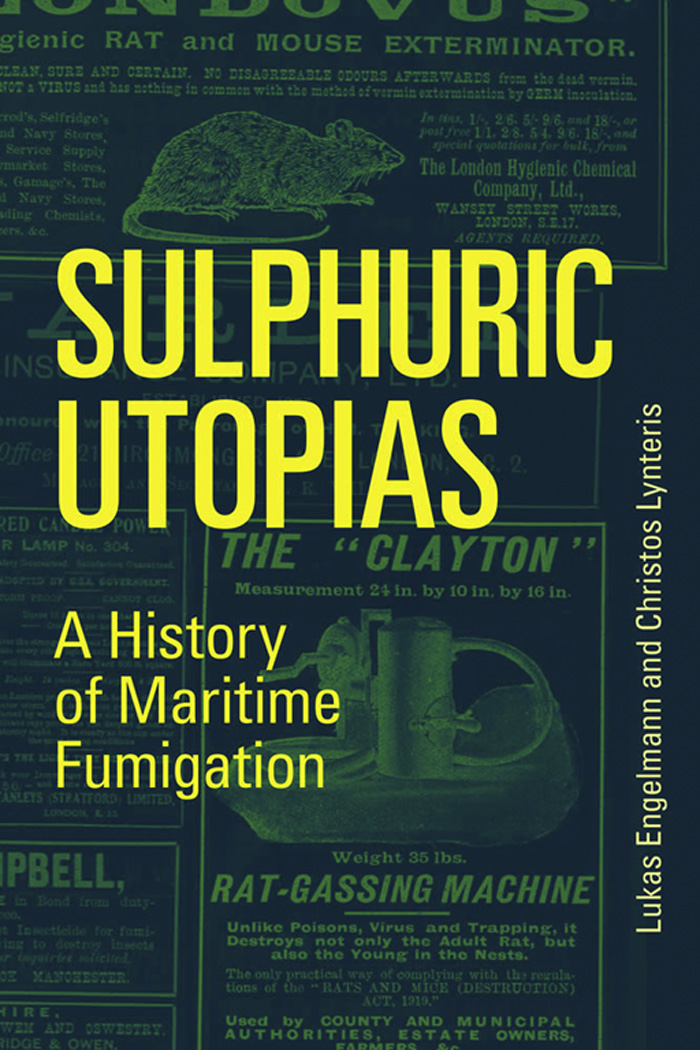
Sulphuric Utopias
Inside Technology
Edited by Wiebe E. Bijker, W. Bernard Carlson, and Trevor J. Pinch
A series list appears at the back of the book.
Sulphuric Utopias
A History of Maritime Fumigation
Lukas Engelmann and Christos Lynteris
The MIT Press
Cambridge, Massachusetts
London, England
2020 Massachusetts Institute of Technology
This work is subject to a Creative Commons CC-BY-NC-ND license.
Subject to such license, all rights are reserved.

The open access edition of this book was made possible by generous funding from Arcadiaa charitable fund of Lisbet Rausing and Peter Baldwin.

This book was set in ITC Stone Serif Std and ITC Stone Sans Std by Toppan Best-set Premedia Limited.
Library of Congress Cataloging-in-Publication Data
Names: Engelmann, Lukas, 1981- author. | Lynteris, Christos, author.
Title: Sulphuric utopias : a history of maritime fumigation / Lukas
Engelmann and Christos Lynteris.
Description: Cambridge, Massachusetts : The MIT Press, [2019] | Series:
Inside technology | Includes bibliographical references and index.
Identifiers: LCCN 2019029666 | ISBN 9780262538732 (paperback)
Subjects: LCSH: Ships--Fumigation--History--20th century. |
Ships--Disinfection--History--20th century. | Chemical apparatus.
Classification: LCC VM483 .E64 2019 | DDC 628.9/6--dc23
LC record available at https://lccn.loc.gov/2019029666
10 9 8 7 6 5 4 3 2 1
d_r0
Contents
Series List
List of Figures
1.1Illustration of Lalouettes fumigation machine.
1.2Illustration of Galss fumigatory box.
1.3Illustration of amended fumigatory box with separate furnace, accommodating six patients.
2.1Map of quarantine stations at the Mississippi River from 1886.
2.2Illustration of the Upper Mississippi Quarantine Station, with a moored barque, attached to a tugboat with a fumigation apparatus.
2.3Illustration of the New Orleans tugboat with a fumigation apparatus installed.
2.4Illustration of the new and improved furnace inside the New Orleans tugboat, used to produce sulphur dioxide gas.
2.5Diagram of the Clayton apparatus.
3.1The Neapolitan Grotta del Cane.
3.2Plan of Nochts fumigation machine.
3.3Photograph of Nochts fumigation process applied to a vessel in the port of Hamburg.
4.1Two types of the Clayton machine from promotional pamphlet, The Clayton Fire Extinguishing and Ventilating Company, Limited.
4.2Diagram of the fumigation of the Matapan.
6.1Scheme to present the brigades interventions in disinfecting a private home.
6.2Map of the progress of deratization campaigns in Buenos Aires.
6.3 Aparato Marot in operation.
7.1Photograph of the display at the Upper Quarantine Station in New Orleans, outlining the uselessness of cats as protection against rats.
7.2Projecting HCN spray directly into rat-infested insulation of a cold-storage room.
Preface
This book is the result of extensive interdisciplinary scholarship and collaboration. Research leading to Sulphuric Utopias brings together the history of science with medical anthropology and science and technology studies (STS), integrating in the process aspects of colonial, world, and oceanographic history and the history of infectious diseases. We have taken recourse to this ensemble of perspectives so as to write the story of a technological contraption, the Clayton apparatus, as a history of sulphuric utopias. This is a history of a set of concepts, practices, and technologies that revolve around the idea of fumigation. At the turn of the nineteenth century and until the 1930s, filling the holds of merchant vessels with gaseous substances that acted on trapped air, as well as on the surfaces of walls and the cargo itself enabled a utopian vision of a maritime space free from disease. Sulphur (we maintain the British spelling of the word, as it was used on both sides of the Atlantic at the time), or rather sulphuric acid gas in particular, was imagined to act with chemical indifference on any disease agent, as well as on the minds of people, thus addressing a range of concepts of disease transmission while providing a spectacular hygienic intervention.
With this book we then address an almost classic history of modernization. Medical officers at the end of the nineteenth century reshaped and rearticulated existing practices in the name of sound scientific principles. They utilized the age-old alchemy of sulphur and ancient traditions of smoking-out and fumigation. They experimented, measured, and tested with the aim of defining the exact capacity of different gases against bacteria, insects, and rodents. But, as we argue in this book, this process of rationalization did not shed its premodern, and perhaps philosophical associations, but instead mobilized them so as to install a specter of total hygienic environments. To overcome the costly, impractical, and untrustworthy system of involuntary detention in quarantine, it was necessary to continue to act on the imaginations of people as much as it required acting on pathogens and disease vectors. As such, this book presents the modern history of the desire to return a built environment, affected and infected by disease, into a status of hygienic purity. It is the history of how the old miasmatic imaginary about the omnipresent effluvia of disease was modernized through a chemically based sanitation process. Fumigation with sulphuric acid gas, on the one hand, acted upon bacteriologically specific agents, insects, and rodents, while, on the other hand, it maintained an unspecific hygienic promise: a sulphuric utopia.
In some ways, this is a history of a failed technology, which populated only a comparably short slice of the modern history of maritime sanitation. Globally dispersed archival sources and a widely forgotten history of fumigation with sulphuric acid gas have contributed to the astonishing invisibility of this story in the history of global health, the history of capitalism, and the history of maritime trade. The Clayton machine appears at best as a footnote to these histories, and its description is often incomplete and inconsistent.
The global dimensions and lasting impact of this effort of establishing a barrier against epidemic diseases are largely overlooked. And so, it is no accident that we encountered the global presence of its principal apparatus, the Clayton, through research on the history of the third plague pandemic (18941959), carried out in the European Research Council (ERC) funded project Visual Representations of the Third Plague Pandemic, led by Dr. Christos Lynteris (grant agreement no. 336564). It was in the global archive of this plague pandemic, following its crossing routes across continents, empires, and epistemic frameworks, where the dimensions and the historical significance of a new system of maritime sanitation became first visible to us. And it was in this global pandemicthe first to be understood and acted as suchwhere we traced the steps of the globalization of an early technoscientific object, which was installed to overcome the past of unspecific diseases and to enable the uninterrupted flow of goods and people in the global distribution of capitalism.
Next page











